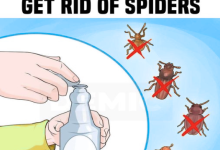
In fact, there are numerous hidden hazards around your house. You probably never thought much about the following home hazards creeping up in your life.
1. Ditch the clutter, especially on stairs

Nearly half of all falling deaths occur on steps and stairways. Keeping the steps clutter-free seems obvious, but take a look at your own steps (especially those leading down to the basement).
It’s easy to use the steps as semipermanent storage, but it’s a very dangerous habit. Odds are that eventually, someone is going to trip over something and break an arm or leg (or neck). Don’t set anything on the steps.
2. Make windows safe for kids

Each year in the United States nearly 15,000 children are injured because of falls from windows. Window screens are not strong enough to prevent falls. In rooms on upper floors, install window guards with quick-release mechanisms (in case of fire) to prevent windows from opening more than a few inches. And keep furniture away from windows so kids aren’t tempted to climb near them. Window guards are available from safebeginnings.com and other online retailers, home centers, and department stores.
3. Potential gas water heater fire

Clothes piled too close to a gas water heater can ignite when the water heater comes on. The protective doors for the gas burners are missing. Appliances (clothes dryers and gas water heaters) cause 7 percent of home fires and 4 percent of deaths. After problems with stoves and heaters, the biggest culprits in appliance fires are lint in dryers and combustibles near gas water heaters.
4. Antiques

The old wiring of antique appliances makes them a safety risk because the wiring dries and becomes brittle, which could fuel a fire. For those who especially love shopping for vintage light fixtures, it’s imperative to know how old the wiring is, if the wiring has been replaced, and whether the wiring is European or from the United States. Look for a UL (Underwriters Laboratories) label somewhere on the wiring for a quick reference to see if it’s safe. UL tests lighting fixtures for safety.
5. Dryer lint

Every year, nearly 25,000 dryer fires cause millions of dollars in damage and hundreds of injuries, some fatal. Dryer fires start when built-up lint near the motor, gas burners, or heating elements catch on fire. This fire can then spread to ignite lint in the vent pipe.
6. Loose outlets

The constant movement of loose electrical outlets can loosen the wires connected to the outlet and create dangerous arcing. Luckily, the fix is simple.
7. Paper

It should go without saying that paper is a huge contributor to home fires, but it’s the location of those papers that people don’t pay close enough attention to at home. Newspaper in the garage near the gas tank for the lawnmower is a common ignition source.
8. Mirrors

While errant papers may seem like an obvious source of home fires, you may be surprised to discover another potential fire starter—mirrors. That’s right, mirrors can reflect the sun, concentrating it on a particular spot, making it a fire hazard. Magnifying makeup mirrors are particularly dangerous. Keep your mirrors away from windows and out of direct sunlight, if possible.
9. Install low-pile carpet

A thick carpet pile over a thick pad is the worst for anyone who is unstable walking—it increases the likelihood of tripping and falling. It also makes it more difficult to push and maneuver wheelchairs and walkers. To make getting around easier, consider installing a low-profile commercial-grade “level loop” or “cut pile” carpet with a pile height of no more than 1/2 in. and a 1/4-in. (10-lb. density) pad.
10. Exercise equipment

Exercise equipment—and their power cords—can be unexpected household hazards. In fact, exercise machines like treadmills and stationary bikes injure more than 25,000 children each year, says CNN. And many of those injuries are related to the power cords of the machines. They can cause tripping and electrical burns, and, for children, can be a strangulation danger. Keeping children out of rooms with such equipment is key, and make sure to unplug the machines and keep the cords safely stowed away when you can.
11. Poisonous house plants

As common as these plants are, certain varieties of lilies, ivies, and other houseplants can be harmful to pets or humans, or both. Stay aware of which plants have the potential to be dangerous, and be sure to keep them out of reach. That way you can take advantage of the benefits of having plants, like air purification and visual interest.






